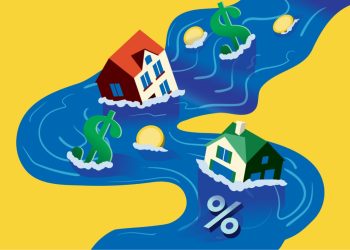 RISMEDIA, June 12, 2009-(MCT)-In the Sacramento Delta suburbs east of San Francisco – where home prices soared and fell as viciously as anywhere in the country – a housing market rebound is feverishly under way.
RISMEDIA, June 12, 2009-(MCT)-In the Sacramento Delta suburbs east of San Francisco – where home prices soared and fell as viciously as anywhere in the country – a housing market rebound is feverishly under way.
A 1,600-square foot rancher listed for $179,000 – after last selling for $425,000 in 2004 – drew multiple offers last month with a high of $210,000 in cash. The topper: The property was a “short sale” whose owner needs lender approval to sell for less than the mortgage owed-and which buyers wouldn’t touch just three months ago.
“My phone was ringing off the hook, my voice mail was on overload and people were coming into the office receptionist saying they couldn’t reach me,” said Christy Howard, a Coldwell Banker Coon and McCreary agent who listed the Antioch house. “Everyone was waiting for the bottom, and the problem is they waited to long, because the bottom has already come and gone.”
Spurred by markdowns up to 80% from market highs, first-time buyers and investors both American and foreign descended en masse in the last three months on San Francisco’s hardest-hit hinterlands as Wall Street and the economic climate improved. They’re picking clean the Delta region’s banked-owned inventory as soon as properties hit the market and are engaged in unprecedented bidding wars even on short sales.
The panicked buying – fueled by buyers’ fear they’ll miss out on fire-sale prices – belies the doom-and-gloom evoked by recent reports of rising mortgage delinquency rates and foreclosure activity. It is one of several overlooked signs the U.S. housing-market turnaround has started in the nation’s hardest-hit markets, which is critical to driving an overall recovery:
– After spending most of the 1990s in the $250,000 range, the median-priced home that was sold in the seven-county San Francisco area rose to a staggering $850,000 by its May 2007 peak. It since fell to a low of $399,000 in February – a 53% drop in just 21 months – before posting its first monthly gain in March, albeit a 1% uptick. The median is expected to continue rising at a healthy clip in months ahead since it’s now at the level of nine years ago, before the bubble began inflating.
– California’s statewide inventory of unsold homes – based on the number on the market divided by the present monthly sales rate – stood at a 15.2 months supply in February, 2008. That figure was down to 5.8 months in March, near the historic average.
– At roughly 22,000 units, Las Vegas’ inventory is not far off its recent record high. Yet total sales closed in March showed flourishing demand, the fourth best on record. That monthly record – set during the height of the boom – is expected to be broken this summer.
“Things have been looking up but it’s going unnoticed,” says Forrest Barbee, a board member with the Greater Las Vegas Association of Realtors and a broker for Prudential American Group Realtors. “It’s just going to take the data a little longer to catch up with reality.” Listen to one analyst’s thoughts about housing having hit bottom.
Adds Rick Sharga, senior vice president of RealtyTrac, which compiles home sales and foreclosure data: “We’ve overshot the market in places like Las Vegas and Arizona in terms of fair value and buyers are bidding prices up again on many properties. The challenge is going to be whether there is enough financing to eat up the inventory that’s yet to come.”
The specter of rising foreclosures – born now of the recession rather than just overleveraged subprime borrowers – is the wild card in future health of the U.S. housing market and the economy by extension. Read about the difficulty borrowers are having with mortgage modifications.
The number of U.S. homeowners behind on payments or in foreclosure shattered the record in the first quarter, the Mortgage Bankers Association reported last week. Nearly one in eight mortgage holders were either delinquent or in the foreclosure process – and prime mortgages in trouble for the first time outnumbered subprime loans on a percentage basis. Read more on the record jump in foreclosures in the first quarter.
Yet the number of pending sales of existing U.S. homes took a surprising upswing in April, rising 6.7% in the biggest monthly gain in more than seven years, the National Association of Realtors reported Tuesday. That increase lags the 9.2% jump in October 2001, but that spike owed to buyers temporarily putting off home shopping following 9/11. See the latest data on pending home sales.
And in an overlooked report that belies the first-quarter delinquency numbers, defaults on privately insured mortgages – where borrowers are more than 60 days behind – fell 3% in April and were down 24% from a record 106,482 in February, the trade group Mortgage Insurance Companies of America reported Friday.
Most important for gauging the strength of the nationwide market is how conditions are improving in the most-depressed regional markets.
With those markets now stabilizing, banks are no longer anxious to dump real-estate owned properties, as houses in their foreclosure portfolios are called, fearing they’ll get appreciably less three months from now for their foreclosed properties.
As a result, they’ll be more judicious about the pace at which they release foreclosures onto the market. The new goal: To maximize the value of supplies in hand rather than unload it helter-skelter and torpedo the housing market like they did while they were shell-shocked by the devastation they’d wrought.
With the banks themselves now somewhat more stable, they’ll also be less likely to want to part with their “toxic assets” knowing the most-scorched, still-serviceable mortgages will be the most valuable on a credit-risk markup once the economy recovers. In fact, the price stabilization in the most-depressed U.S. markets will allow a clearer valuation of the toxic assets we now all hold by virtue of bank bailouts – a modicum of certainty that will hasten the overall recovery.
Homeowners in most of America know by their own property’s value that the spike in U.S. median home values was driven in considerable measure by soaring prices and volume in major markets, especially in California, Florida, Nevada and Arizona. By virtue of their climates and economic-growth rates, those four states have been on the extremes of the U.S. boom-and-bust housing cycle since the 1950s.
You can’t discount how critical an upturn in those states will be, considering they account for 46% of foreclosures nationwide. If foreclosures there are more quickly consumed as they’re starting to be now – fueled in part by foreign buyers who recognize their value – we’ll all reap a return on our bailout money a lot faster.
“The banks are getting smarter and realizing that if they don’t sell it in a short sale, they lose more money going the foreclosure route,” Barbee said.
Adds Sharga: “The banks will be very particular and thoughtful about how they’ll release new foreclosures, because they know now how flooding the market will have a disastrous effect.”
That, and if the chastened lenders would just swallow crow and pony up for rights to an encouraging Beatles song to play on their delinquent-payers’ hold line: “We can work it out.”
©2009, MarketWatch.com Inc.
Distributed by McClatchy-Tribune Information Services.










